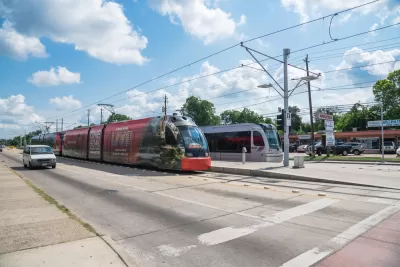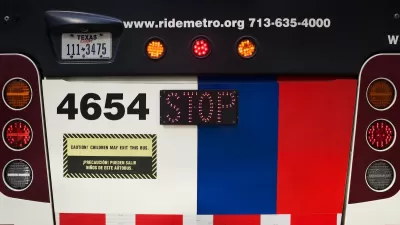The lull in commuter traffic during the pandemic gave Houston's transit agencies time to implement new projects and redesign downtown roads to better accommodate transit users.

Dug Begley reports on Houston's newest bus-only lanes, slated to cover over two miles of downtown streets "as part of a three-phase project to freshen the bus-only lanes managed by Metropolitan Transit Authority. Paint could be spread across four blocks of Travis by fall, though the total project will take up to a year, and up to $1.5 million."
According to Kimberly Williams, Metro’s chief innovation officer, "[t]he goal is to take advantage of the slowdown in traffic downtown while it lasts to freshen the existing bus lanes." Williams said the agency sees this "very much as a safety project, as well, because it creates structure among all the users downtown." The project "is one of many changes under construction, planned or being considered downtown as Metro, Houston Public Works and the Houston Downtown Management District accelerate work while many offices are unoccupied."
"City, downtown and Metro officials, meanwhile, are working on plans to stop allowing vehicles to share light rail lanes along Capitol and Rusk. If redesigned, only trains and, perhaps some buses, would occupy the lanes, turning them into transit byways of the street grid in the central business district." A 2019 report assessed the dangers inherent in sharing lanes and "suggested eliminating the shared lanes and allowing only trains to use them. Removing cars and trucks, however, will require further study of the safety benefits and the effects on traffic, including the need for turns across the tracks."
FULL STORY: What's red and white and spread across downtown? Pretty soon, transit-only lanes

Alabama: Trump Terminates Settlements for Black Communities Harmed By Raw Sewage
Trump deemed the landmark civil rights agreement “illegal DEI and environmental justice policy.”

Study: Maui’s Plan to Convert Vacation Rentals to Long-Term Housing Could Cause Nearly $1 Billion Economic Loss
The plan would reduce visitor accommodation by 25% resulting in 1,900 jobs lost.

Planetizen Federal Action Tracker
A weekly monitor of how Trump’s orders and actions are impacting planners and planning in America.

Waymo Gets Permission to Map SF’s Market Street
If allowed to operate on the traffic-restricted street, Waymo’s autonomous taxis would have a leg up over ride-hailing competitors — and counter the city’s efforts to grow bike and pedestrian on the thoroughfare.

Parklet Symposium Highlights the Success of Shared Spaces
Parklets got a boost during the Covid-19 pandemic, when the concept was translated to outdoor dining programs that offered restaurants a lifeline during the shutdown.

Federal Homelessness Agency Places Entire Staff on Leave
The U.S. Interagency Council on Homelessness is the only federal agency dedicated to preventing and ending homelessness.
Urban Design for Planners 1: Software Tools
This six-course series explores essential urban design concepts using open source software and equips planners with the tools they need to participate fully in the urban design process.
Planning for Universal Design
Learn the tools for implementing Universal Design in planning regulations.
Caltrans
Smith Gee Studio
Institute for Housing and Urban Development Studies (IHS)
City of Grandview
Harvard GSD Executive Education
Toledo-Lucas County Plan Commissions
Salt Lake City
NYU Wagner Graduate School of Public Service





























